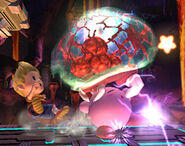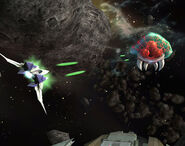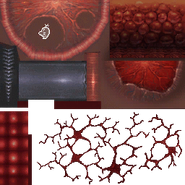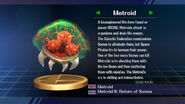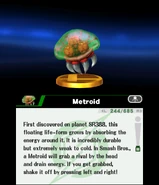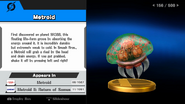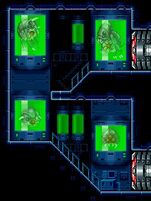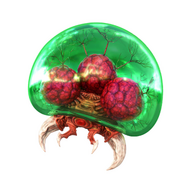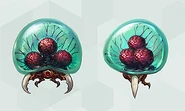This page covers the Larva Metroids encountered in the side-scrolling games of the Metroid series, including Other M. For the similar strain featured in the Metroid Prime series, see Tallon Metroid.
A Larva Metroid, or Generic Metroid[1] is the third stage of the Metroid's life cycle. An extension of the prior Infant stage, this iconic form is the most common and recognizable of the species in the series of the same name. In fact, the larvae are encountered so often that they are usually referred to simply as "Metroids". Larva Metroids are extremely ravenous and are constantly seeking to eat as much life energy as possible.
On the Metroid homeworld of SR388, all larvae eventually metamorphose into Alpha Metroids.
Larval Metroids possess unique biological traits that make them a favorable specimen over the later stages of their life cycle for bioweapon research and experiments.
Physiology
The body mostly consists of a thick, round, translucent membrane resembling a jellyfish's hood, typically ranging in color from green to blue. Within this membrane can be seen four red, spherical organs resembling nuclei, closely arranged so only three are visible from most angles. Many neuron-like connections grow out of these nuclei, branching throughout the Metroid's upper body. The larva's leech-like mouth lies beneath the membrane, and features two pairs of mandibles: the larger pair for gripping their prey, and the smaller for siphoning out its life energy. The aforementioned mouth is likely used in conjunction with the large fangs to strengthen their hold on prey.
Abilities and behavior
Larva Metroids perpetually fly in the air despite lacking any visible means of propulsion. They are also able to somehow see their surroundings without the use of conventional sensory organs.
When they detect the presence of prey, they will begin pursuing it relentlessly; their single method of attack consists of attaching themselves to the target, usually on the upper half of the body (covering the head and chest in their entirety if possible) and continuously absorb its energy. Once attached, the organisms are nearly impossible to dislodge and will rapidly drain their victim's life energy entirely, often killing it in seconds. When a Metroid is feeding, any others nearby will either patiently wait for the opportunity to take the former's place if it loses its grip, or simply feed on any unoccupied parts of the victim; in the latter case, the rate of which the energy is drained from the body is increased dramatically. Detonating Morph Ball Bombs in close proximity is the only known way of removing an attached larval Metroid, consequently making Samus one of the very few beings capable of surviving such an attack. While there are two other notable survivors, they overcame different forms of Metroid that attack in the same manner as a larva:
- Proteus Ridley was strong enough to tear an Infant Metroid off his face with his hands.
- Mother Brain was capable of resurrecting herself after being completely drained by the Giant Metroid.
Similar to the larvae of insects, Larva Metroids are highly ravenous and will feed on any and all living organisms they encounter, with the exception of their own species. They are capable of draining the energy from artificial life forms and technology as well, such as Samus' Power Suit. It can be assumed that their hunger is driven by a need to fuel their metamorphosis to the next stage(s) of their life cycle; indeed, older individuals are noticeably less gluttonous.
Despite these ferocious traits, Larva Metroids have the capacity to heal wounded organisms by giving them life energy drained from other victims. This is known through the actions performed by the baby in both its Infant (Metroid: Samus Returns) and mutated Giant Metroid (Super Metroid) forms, which are stages that preceded and followed its Larva form respectively. The energy stored in a Larva can also be forcefully drained and used for other purposes, allowing the creature to be used as a living rechargeable power cell. However, a scan in Metroid Prime 2: Echoes reveals that repeated energy drains can cause cellular breakdown to occur in the Metroid.
A trait that is seemingly unique to both the Infant and Larva forms is their ability to asexually reproduce via division when exposed to Beta-rays. This process is akin to a cell undergoing mitosis. Thus, their numbers can be artificially increased without the need of a Queen Metroid laying Metroid Eggs.
Membrane and nuclei
Contrary to all later stages in the species' life cycle, a larva's membrane is extremely durable. In fact, no conventional weapon is capable of wounding the creature unless it is first exposed to its major vulnerability: cold temperatures. Metroid larvae tend to become sluggish in frigid conditions and their membranes are easily frozen solid with the Ice Beam, allowing the creatures to be shattered and killed by concussive weaponry, requiring either five Missiles or 1 Super Missile. Power Bombs can also sometimes harm them, though their level of effectiveness varies widely; the larval Metroids on Zebes die within three detonations, while the original strain from SR388 are completely invulnerable to their explosions. In addition, a Power Bomb can shake off an attached Zebesian Metroid.
Though it has yet to be explained why the membranes of older Metroids can be readily harmed without the need to freeze them first, it is worthy to note that only Infant and Larva Metroids possess four nuclei. The later Alpha, Gamma, Zeta and Omega Metroids have lost all but a single nucleus, which not only suggests that this affects the membrane's defenses, but also that the missing nuclei transformed into the new bodies observed in the stages following the larval form. The nuclei can thus be interpreted as having a similar function to stem cells.
Adaptations and mutations
One of the most concerning qualities of a Larva Metroid is its capacity to adapt on any planet, with the exception of those with global sub-zero climates. A foreign world's atmospheric and environmental stimuli can trigger the larva's body to go through either subtle or drastic changes, seemingly with the purpose of allowing the organism to roam and hunt on the new planet without hindrance.
This adaptation is not flawless however. Without SR388's environmental conditions and possibly its Aeion radiation, the larva will be unable to metamorphose into the advanced, less voracious stages observed on its homeworld, consequently trapping the organism in a perpetual state of hunger. This turns the Metroid into a major threat on an alien planet, as a small number of insatiable Larva Metroids could potentially wipe out all life on it. This danger is further compounded by their invulnerability to most forms of weaponry as well, which makes dealing with the invasive Metroids an extremely difficult task for the native inhabitants.
Interestingly, it is the Larva Metroid's inability to molt outside of SR388 that caused the erroneous belief that the iconic, jellyfish-like phase was the only form of the species, unaware of the fact that further developed Metroids could be found on the unexplored homeworld. Coincidentally, Larva Metroids were the first specimens discovered by the Galactic Federation and the first form given to the entire species by their Chozo creators.
These adaptations, along with their extracting of life energy, high defenses and the Beta-Rays' capacity to increase the Metroids' numbers artificially, are what caused the Space Pirates to gain such a high interest to use the organisms as bioweapons. Furthermore, it was discovered that the larvae are particularly responsive to radioactive elements such as Phazon. Within a few years, research and experiments performed on their near-limitless supply of specimens across differing planets led to the creation of many mutants. Each aberration possesses unique qualities and some manage to escape their larval phase entirely despite being outside of SR388, allowing the Metroids to achieve radically altered forms. In time, the Galactic Federation itself would begin seeking to use Larva Metroids for its own purposes as well.
For a complete list of mutations in the species created through various means such as radioactive exposure, genetic manipulation, adaptation to foreign planets and more, click here.
Relationship with the Chozo

A Larva Metroid being released by the Chozo in Area 7
Although Larva Metroids have been known throughout the series as untamable, vicious predators constantly seeking out food (with the exception of the baby), the Chozo Memories featured in Metroid: Samus Returns reveal this was not always the case.
Indeed, when the creation of the very first Metroid was completed in the Chozo laboratory, their creators are shown confidently releasing it from its container in their presence. Several larvae are then seen accompanying the Chozo in their hunt for X Parasites; the Metroids are solely targeting all things related to the X (their pure form, infected victims and mimicries) without harming the Chozo. A third image demonstrates the Metroids continuing to roam freely in close proximity of the Chozo, as the former keep the latter safe from X Parasite stragglers.

The Chozo using Metroids to kill X Parasite creatures
This peaceful cohabitation would come to an end when the Metroid larvae molted into the advanced stages of their life cycle. The Chozo began to lose control of the species and are shown being attacked by their creations, leading to the end of their civilization on SR388.

The Chozo accompanied by their tamed Larva Metroids.
It is unknown how the Chozo managed to keep larval Metroids tame for as long as they did. All future attempts to do so by Space Pirates have ended in failure, as evidenced by numerous casualties. The Galactic Federation's facilities have always kept their Metroid specimens contained, an indication that they are also unsuccessful in controlling them.
Official data
Metroid manual
"This protoplasm in suspended animation was discovered on the planet SR388. It clings onto Samus' body and sucks his[2] energy. It can't be destroyed directly with the normal beam. Freeze it with the ice beam, and then fire 5 missile blasts at it."
Virtual Console retranslation
"This protoplasm, discovered on the planet SR388, clings to Samus and drains her energy. It can't be defeated with a normal beam, just repelled. Use a combination of the Ice Beam and missiles to defeat it."
Official Nintendo Player's Guide
"This is a mysterious life form which was discovered on the planet SR388. It sticks to Samus’ body and sucks out her energy."
Metroid II manual
"This is their first shape after hatching from eggs. They will cling to any creature that they can find, drawing its victim's life energy away."
Super Metroid manual
FLOATING LIFE FORMS - METROIDS
"It is said that Metroids are life forms created by an ancient civilization. Metroids engulf living creatures and absorb their energy. They are very intelligent and quick to reproduce."
Super Metroid Nintendo Player's Guide

A Larva Metroid in Super Metroid.
"Freeze them, then blast them with Super Missiles."
Super Metroid Players' Guide
- The Metroids (page 70)
- "These aliens are tough with a capital T! You need to freeze the sucker first, then follow up with either one Super Missile shot or five missiles. You'll need to use bombs to shake it off if it grabs hold of you."
Official Metroid Fusion website
"These energy-based creatures have the ability to absorb the life force from any living thing. As the natural predator of X-Parasites, however, the Metroid may now be the key to Samus's survival."
An energy-based life-form with a translucent, spherical upper body. Claw-like spikes protrude from the lower-half of the creature, which it uses to latch onto its prey."
Metroid: Zero Mission manual
"Metroids are the floating organisms discovered on planet SR388. These fearsome predators latch onto other organisms and leech the life energy out of their prey."
Official Metroid: Zero Mission website
"SPECIMEN ID# M-1A
"Extremely dangerous! Gelatinous exterior of Metroid makes it impervious to beam weapons. Metroids can only be destroyed by Missiles while frozen. Large claws grip prey while smaller front fangs drain its life force. Transform to Morph Ball and use Bombs to escape grip. DANGER LEVEL: HIGH"
- "Gelatinous exterior"
- "Multiple brain stems"
- "Gripping claws" (Outer)
- "Energy-sapping fangs" (Inner)
Official Metroid Prime Website
"Metroids are highly dangerous parasites averse to cold temperatures. The dominant species of planet SR388, Metroids can suck the life force out of living things. A Metroid will latch onto its prey and drain energy, growing larger as it does.
Metroid Prime Pinball manual
"An energy based, highly dangerous parasite."
Metroid: Samus Returns Official Guide
- Metroid larva (p. 21)
- "The quintessential Metroid by most players’ reckoning, the Metroid larva is the standard green, bulbous creature adorned with three eye-like organs and is only too happy to sap the life energy out of anything it can wrap its mandibles around. Like all Metroids (save for the Queen), Metroid larvae hate the Ice Beam, but they’re particularly weak against it, compared to their older brothers and sisters. Combine the frosty weapon with a missile or two, and Metroid larvae offer little more threat than a kitten."
Smash Tips
"These alien creatures float around and then try to clamp down on you with their sharp fangs. Quickly struggle to break free from their grasp."
Smash Tour (SSB4 Official Game Guide)
"Lasts 5 turns or until a player bumps into it two times"
"Bumping into this enemy costs you several stat boosts! Reclaim lost stat boosts by bumping ino it a second time."
Appearances in other media
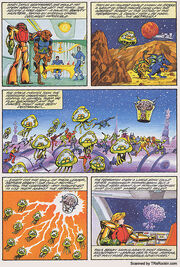
Metroids appear in Nintendo Comics System's The Coming of a Hero, Deceít Du Jour, and Captain N: The Game Master's Breakout
Non-canon warning: This article or section contains information that may not be considered an official part of the Metroid series in the overall storyline by Nintendo.
- Metroids appear in the Kid Icarus franchise, under the name Komayto, which is stated in the instruction manual to have come from another planet. This creature can be found flying around Skyworld in packs. Kid Icarus was also created using the Metroid game engine. During the game Kid Icarus: Uprising, the main character Pit states himself that "Komaytos kind of look like little Metroids" before being hushed by Viridi.
- A Metroid is a collectible treasure in Wario Land II. They are also often in 9-Volt's microgames in the WarioWare series, such as WarioWare, Inc.: Mega Microgame$!, WarioWare, Inc.: Mega Party Game$!, WarioWare: Touched! and WarioWare: Twisted!.
- Metroids made an appearance in Kirby's Dream Land 3 for the SNES. If Kirby freezes all the Metroids in the level, Samus removes her helmet and gives Kirby a Heart Star.
- Metroids wander onto stages randomly in Metroid Prime Pinball and also have their own minigame, Metroid Mania.
- In Metroid Prime 3: Corruption, a Metroid is used on the tab for the creatures section of the Logbook. Interesting to note is that the Metroid depicted here has six nuclei, five encircling the top of a larger, centralized nuclei.
- The Baby from Metroid II: Return of Samus and Super Metroid appears as an item in the Nintendo DS game Animal Crossing: Wild World. It appears in its signature capsule, and if tapped will play a few seconds of the Super Metroid title screen theme. It is a rare item that is acquired randomly by shooting down Gulliver. The item also appears in Animal Crossing: City Folk, but cannot be transferred through the ingame catalogue due to the item's rarity. It acts the same way as before and is obtained in the same manner as well; it will play the entire Super Metroid theme this time however. The same item appears once again in Animal Crossing: New Leaf, but it is not obtained through the same method as the two previous games. Instead, it is randomly acquired through fortune cookies, which the player can buy using two of the 3DS's Play Coins. This version also plays only a few seconds of the title theme.
- In Tetris DS, there is a single player game mode called Catch Mode where players catch Tetraminos (blocks) in order to create a 4X4 square and detonating it to make the cluster smaller. The Brinstar theme plays during this and encapsulated Metroids (in capsules similar to the Metroid hatchling's) fall down. If touched, the energy meter will go down and the cluster becomes smaller.
- A Metroid can be seen on Nintendo Monopoly representing St. James Place for $180.
- A Metroid is shown in a capsule in Singularity along with the message "Mother my brain hurts".
- A Metroid is seen in a tank in Starcraft 2: Wings of Liberty in the secret Mission "Piercing the Shroud." It is very similar to that of the baby.
Super Smash Bros series
- Metroids appear in a minor reference in Super Smash Bros., in Super Smash Bros. Melee as a trophy as well as the baby being seen in the opening cutscene, and in Super Smash Bros. Brawl and Super Smash Bros. for Nintendo 3DS and Wii U as an Assist Trophy that will latch onto opponents and "drain" them of energy (what they actually do is increase the victim's damage, but can still sap health if a stamina match is being played). It can be shaken off, which will cause it to try and seek another victim. It can phase through platforms similar to a Phazon Metroid. Using Up-Special moves while the Metroid is latched on to a character cancels the move after the few starting frames; this can be done multiple times in a row. This allows some characters to stay in the air for quite a while. Interestingly, the model of a larval Metroid used in-game for the Nintendo 3DS and Wii U games exhibits unnaturally large inner-fangs; in fact, they appear to be larger than the outer ones. In Melee, the intro scene from Super Metroid is reflected off of the trophy, with the infant missing from the scene.
Super Smash Bros.
Metroids are briefly mentioned in Samus's "Characters" bio in the "Data" section of SSB. Her bio says that Samus "...pursues the airborne life form, Metroid, throughout the whole universe."
Super Smash Bros. Melee
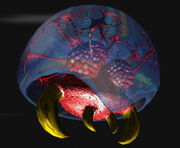
Super Smash Bros. Melee website.
"A parasitic life form that can absorb all types of energy, Metroids have strong resistance to most conventional weaponry. To defeat them, Samus Aran had to freeze them with Ice Beam shots and then blast them with missiles. Mochtroids, which look like Metroids, are weaker, with fewer internal nuclei."
(Metroid 08/89).
Super Smash Bros. Brawl
"A bioengineered life-form found on planet SR388. Metroids attach to organisms and drain life energy. The Galactic Federation commissions Samus to eliminate them, but Space Pirates try to harness their power. One of the few ways Samus can kill Metroids is by shooting them with the Ice Beam and then shattering them with missiles. The Metroid's cry is chilling and indescribable."
Metroid (1987)
Metroid II: Return of Samus (1991)
Smash Bros. DOJO!! data on the Assist Trophy
"Like the name says, this Assist Trophy is from the game Metroid. It's an artificial life-form that absorbs all kinds of energy.
In our game, it also attaches to the head and starts to drain its victim. Since it will increase your damage, try to shake it loose."
Super Smash Bros. for Nintendo 3DS and Wii U
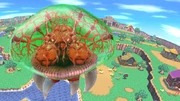
Stickers
- Metroid Metroid Prime Pinball - [Freezing] Attack +18 (All)
- Metroid Metroid: Zero Mission - [Electric] Attack +20 (Samus, Zero Suit Samus)
Super Smash Bros. for Nintendo 3DS and Wii U Trophy
- NTSC
- "First discovered on planet SR388, this floating life-form grows by absorbing the energy around it. It is incredibly durable but extremely weak to cold. In Smash Bros., a Metroid will grab a rival by the head and drain energy. If you get grabbed, shake it off by pressing left and right!"
- PAL
- "Mysterious floating life-forms, discovered on the planet SR388, that absorb energy from other living beings. They're tough, except when they're cold. In this game, they'll try to attach themselves to fighters' heads and drain their energy. Press all the buttons you can to shake them off!"
Nintendo Land
Metroids appear as robots. They can suck out the Mii's energy but they also like to drop Miis in the Lava on the volcano map. Metroids must be frozen with the Ice Charge before shooting their core to kill them, reminiscent of how they are killed in the official Metroid games. This game also implies that the Chozo went extinct because they lost control of the Metroids.
Non-canon warning: Non-canonical information ends here.
Trivia
- Metroid Fusion remains the only game featuring the Metroid species that did not have its larvae in an active role. Indeed, the only Larva Metroid in the game is kept in suspended animation within a container in the background.
The only Larva Metroid seen in Metroid Fusion.
- The artwork of the Larva Metroid made for Samus Returns features a red spot under the creature's membrane, in-between the smaller pair of fangs. In some cases, it resembles a red eye. This is a peculiar detail, as the Metroid is not known to possess any ocular organs until it develops into an Alpha Metroid.
- The amount of time a Larva Metroid stays encased in ice after being hit with the Ice Beam varies throughout the series. Currently, Metroid: Zero Mission and Samus Returns are the games in which the organisms remain frozen for the shortest period (approximately two seconds and less).
- The factor that determines whether multiple larval Metroids will group-feed on a single target, or wait for the chance to replace the one currently eating, is unknown. This behavior usually varies between the games, with the larvae from the original Metroid, Metroid II and Super Metroid being able to simultaneously feed on Samus. Those featured in Other M and Samus Returns will instead float nearby if one of their own is already feasting. Zero Mission is currently the only game to exhibit both behaviors, as Larva Metroids can be seen in a cutscene group-feeding on a Zebesian Pirate, but will take turns attacking Samus during gameplay.
- In the first three games of the series, Metroids that simultaneously fed on Samus would occupy the same area of space (her body's upper half), effectively distorting their sprites with each additional individual. With proper timing, she can shake them all off simultaneously with a single or multiple Bomb detonations and quickly freeze all larvae with a single Ice Beam shot due to their sprites being so closely compacted together. This is difficult to pull off, as improper bombings will fail to remove all attached Metroids at the same time.
- Group-feeding behavior was observed in Infant Metroids during the events of Metroid Fusion, specifically when they attacked an SA-X in the Restricted Laboratory.
Gallery
Notes and References
- ^ Hologram in Metroid: Other M
- ^ The English manual for troid deliberately referred to Samus as a male, not a female
| Bioweapons | |
|---|---|
| Space Pirates | Bombu • Class I Energy Harvester • Elite Pirate • Megaroid • Metroids • Mimic • Omega Pirate • Phazon Elite • Preed • Puffer Mine |
| Galactic Federation | Cyborg Zebesian • Nightmare • Queen Metroid • Super Zebesian • Unfreezable Metroid • X Parasite (desired) • SA-X (desired) |
| Other | Kanden • Quadtroid |
| Related | Bioweapon Research Center • Project Metroid Warriors •Special-forces unit |


